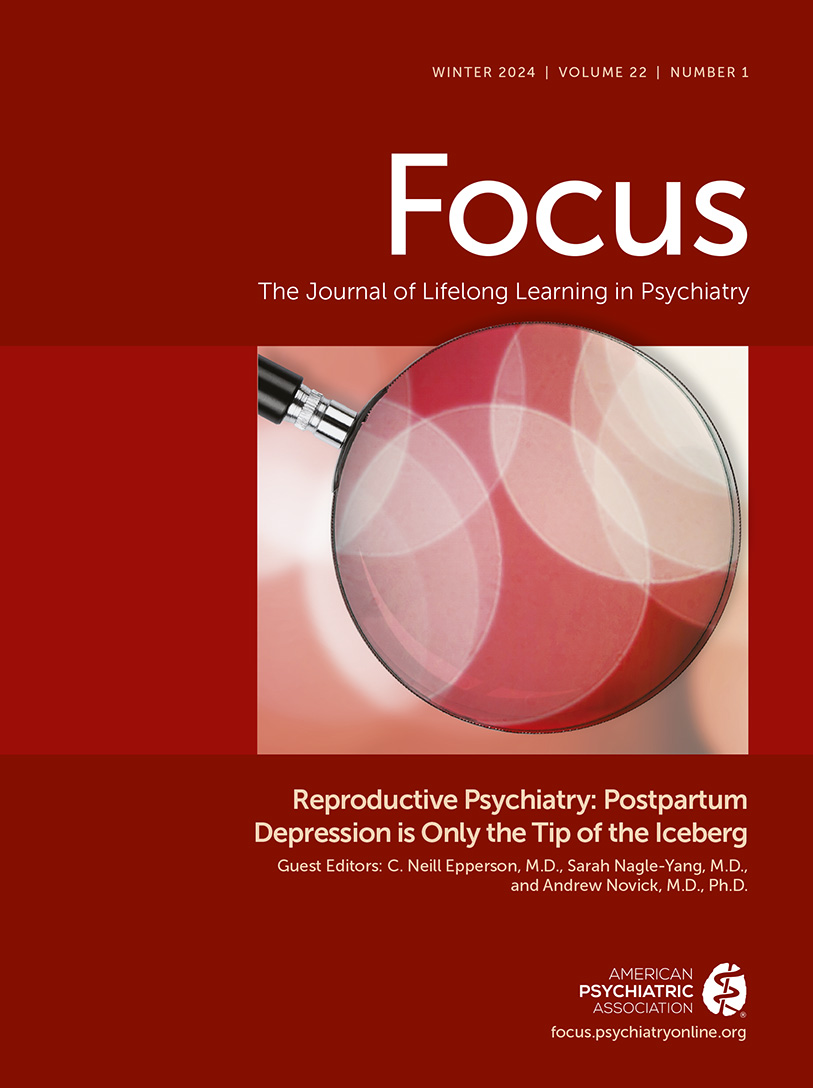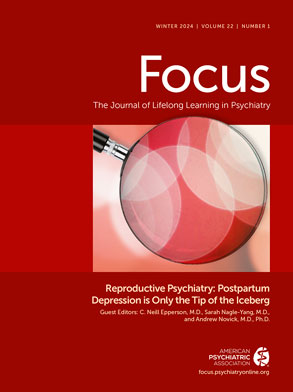The informal specialty referred to as “reproductive psychiatry” has become synonymous with perinatal mental health in many circles. Perhaps this is due to the imperative of reproduction being survival of the species, giving life to another human being, as well as the complexity facing the psychiatrist who must consider the well-being of both the fetus and the mother. However, individuals with the capacity to conceive spend, on average, less than 10% of their lifespan being pregnant or postpartum, if they choose to reproduce at all. This issue of Focus seeks to emphasize the importance of the entire reproductive lifespan, from menarche to menopause, to the care of individuals identified as female at birth.
Puberty heralds onset of the well-described sex bias for females to experience DSM-5 mood-, anxiety-, and stress-related disorders to a greater degree than their male contemporaries. Females also experience fluctuations in risk for these disorders depending upon their hormonal status, which changes across the menstrual cycle, during pregnancy and postpartum, and with the menopause transition. Polycystic ovary syndrome (PCOS), an endocrine issue specific to females, is associated with significant psychiatric comorbid conditions but is seldom considered in the practice of psychiatry. Moreover, females compared with males are more likely to seek psychiatric care, creating the necessity for psychiatrists to gain greater expertise in the assessment and management of psychiatric conditions related to or affected by menstruation, pregnancy, postpartum, and menopause.
Ovarian, or reproductive, hormones, which vary naturally in levels and cyclicity across the female lifespan, have profound effects on brain regions critical to complex human experiences and behaviors such as mood, affect regulation, cognition, sleep, food intake, and reward processing in addition to sexual function. There are numerous reasons individuals manipulate their hormones, from the desire to ablate menstruation as part of gender-affirming hormone interventions to the removal of the ovaries to decrease risk for estrogen-responsive cancers. The modern practice of even general psychiatry must consider these natural and exogenously induced changes in gonadal steroids as potential contributors to their patient’s psychiatric presentation and treatment.
For this issue of Focus, we asked clinical, programmatic, and research experts in the area of reproductive psychiatry to provide an update on new treatments and considerations for women across the lifespan. Articles focusing on the perinatal window of the reproductive lifespan, including one by Hasser et al., “Striking the Balance: Bipolar Disorder in the Perinatal Period,” demystify the complexity in managing maternal mental illness while supporting the health and well-being of the pregnancy and developing fetus. Weingarten and Osborne, in “Review of the Assessment and Management of Perinatal Mood and Anxiety Disorders,” provide a critical overview of the assessment and treatment of both depression and anxiety during pregnancy and postpartum. Importantly, they address the presentation of obsessive-compulsive disorder during the postpartum and provide tools to distinguish this condition from postpartum psychosis. Maternal mortality remains a critical problem in the United States and opioid overdose is a leading cause. Witcraft and colleagues, in their article, “The Psychiatrist’s Role in Treating Perinatal Opioid Use Disorder and Reducing Maternal Mortality,” review the standard of care for opioid use disorder in the pregnant and postpartum individual, including practical tips for the general psychiatrist. “An Overview for the General Psychiatrist Evaluating Patients with Obstetric and Neonatal Complications and Perinatal Loss,” by Gopalan et al., focuses not only on the impact of grief and loss related to infertility, perinatal demise, birth trauma, and neonatal death, but also describes the complexity introduced by the recent Dobbs v Jackson Women’s Health Organization ruling has had on individuals and their ability to terminate a pregnancy. Finally, postpartum psychosis is a psychiatric emergency, and the general psychiatrist will benefit from the comprehensive review by Toor et al., in “Postpartum Psychosis: A Preventable Psychiatric Emergency,” which details the assessment and treatment (including the use of electroconvulsive therapy) for this life-threatening disorder.
As endocrinopathies can present with symptoms of disordered behavior, mood, and cognition, the general psychiatrist will want to develop a knowledge of the assessment and treatment of PCOS. Standeven and coauthors, in “Bridging the Gap: Integrating Awareness of Polycystic Ovary Syndrome Into Mental Health Practice,” summarize clearly the methods for assessment of PCOS in psychiatric practice and how providers can work with gynecologists to best manage the psychiatric and other medical manifestations of this exceptionally common disorder. The management of premenstrual dysphoric disorder (PMDD) is not entirely straightforward when it is difficult to determine whether a presentation represents a premenstrual worsening of an ongoing psychiatric disorder or a diagnosis of PMDD. Carlini et al. (2022) (found in the issue bibliography) provide practical suggestions for the general psychiatrist who may not fully understand the role of steroid contraception in the worsening or ameliorating of PMDD symptoms. Wagner-Schuman et al. (2023) (found in the issue bibliography) highlight the important role that ovarian suppression with gonadotropin-releasing agonists and antagonists has in the treatment of severe PMDD that is not responsive to standard treatment with selective serotonin reuptake inhibitors.
Finally, the Ask the Expert feature by Epperson as well as the reprinted Influential Publication by Page et al. (2023) highlight the impact peri- and postmenopausal states have on cognition, particularly executive functioning. The treatment of these symptoms during the menopause transition is complicated by the increased risk for major depressive disorder, sleep disturbance, and depression and anxiety symptoms, as each can contribute to or exacerbate the onset of executive functioning complaints. The general psychiatrist who is treating midlife women or those who undergo surgical menopause for cancer risk reduction will benefit from understanding the natural history, assessment, and treatment of these common complaints.
The editors of this Focus issue recognize that not all individuals assigned female at birth consider themselves to be women and may choose to manipulate hormones to achieve a desired phenotypic effect. Unfortunately, there are limited empirical data describing reproductive mood-related conditions among these individuals, although a growing literature indicates that the majority of individuals report improved mental health once their gender identity and physical phenotype are consistent.
Despite the complexities and need for additional research within reproductive psychiatry, we hope that the articles in this issue of Focus communicate two overarching messages for readers: 1) that the psychiatric influence of biological and psychosocial pressures across the reproductive lifecycle should not be discounted or ignored and 2) evaluating and addressing these influences is not outside the realm of the general psychiatrist.

